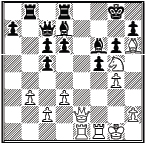Black goes Pawn grabbing and just when it looks like he has gotten back on defense, White comes crashing through the kingside. Just too much firepower for White at the point of attack. And, although this game does not end in checkmate, you will have to agree that it belongs in this book.
White: Joel Johnson (2100)
Black: John Cline (2200)
[B23] Closed Sicilian
Northeast Chess League, Nashua, NH, 02/15/1979
1.e4 c5 2.Nc3 Nc6 3.f4 g6 4.Nf3 e6 5.e5 Nge7 6.Bb5 Nd5 7.Ne4 Be7 8.0-0 f5 9.exf6 Nxf6 10.Bxc6 bxc6 11.Nxf6+ Bxf6 12.Qe2 0-0 13.Rb1 Qa5 14.d3 Qxa2 15.Bd2 Rb8 16.f5 exf5 17.Bh6 Rd8 18.b3 Qa5 19.Ng5 d6 20.g4 Qc7 21.Rbe1 Bd7
It’s my move, what do I see? First, I realize that I have given up two Pawns and need to do something significant soon, otherwise, the two Pawns down will eventually cost me the game, Also, because I am down two Pawns, I cannot play moves that will just trade off pieces.
Next, I notice that all of White's pieces are on the kingside, while Black currently only has one piece defending the kingside (the Bishop on f6).
My plan, therefore, is to continue with my kingside attack by exploiting my localized material advantage.
When I started analyzing this position, I felt comfortable playing a move like 22. gxf5. However, as I looked some more, the shocking move, 22. Qe7 popped up on my radar. A very interesting move indeed. Yes, the move loses my Queen for Black's lone kingside defender, but does it work? You need to be really sure when you give up your Queen for what amounts to a positional checkmating attack. You need to be aware that Black will be looking very hard for ways to disrupt and even completely derail my plans. He could for example, sacrifice some material back to kill my attack and win the endgame. So, I analyze: 22. ... Bxe7 23. Rxe7 (threatening 24. Rg7+ if 24. ... Kh8 25. Nf7# mate and if 24. .. Kf8 25. Nxh7+ Ke8 26. Nf6+ Kf8 27. Rh7#.) 23. ... Rf8 (only move) 24. Rg7+ Kh8 25. Rxh7+ Kg8 26. Rg7+ Kh8 27. Re1 - Wow! Black cannot stop the other White Rook from also reaching the 7th rank and joining in on the attack. For example, if 27. ... Rbe8 28. Rxe8 and Black cannot recapture the Rook without losing a Queen or getting checkmated. At this point, it is apparent that my plan is very, very strong, so, I played:

22.Qe7!! Bxe7 23.Rxe7 Rf8 24.Rg7+ Kh8 25.Rxh7+ Kg8 26.Rg7+
Just trying to gain some more time on the clock, as I have used quite a bit. This is very common in events where the time control is based on a specified number of moves in a specified amount of time.
26. ... Kh8 27.Re1 Qa5 28.Ree7 Qa1+ 29.Kg2 Be8 30.Rh7+ Kg8 31.Bg7 1-0
Black has only one way to avoid checkmate, with the following line: 31. ... Rf7 32. Rxf7 Bxf7 33. Bxa1 (threatening 34. Rh8#) 33. ... Kf8 34. Rxf7+ with an easy win.
Final Position
Life Master Brian Wall has created two wonderful videos on YouTube titled “First Blood - Parts I & II”. “Must see” videos for any serious chess player looking for more information about the “Fishing Pole”.
White: Walter Browne (2550)
Black: Francisco Baltier (1550)
[C65] Ruy Lopez
40 Board Simul, Las Vegas, NV, (Round 1), 10/11/2007
1.e4 e5 2.Nf3 Nc6 3.Bb5 Nf6 4.0-0 Ng4 5.h3

5. ... h5 6.Nc3 Bc5 7.Nd5 a6 8.Ba4 d6 9.d4 Ba7 10.hxg4 hxg4 11.dxe5 gxf3 12.g3 b5 13.Bb3
13. ... Nd4 14.Re1 Qd7 15.e6 fxe6 16.e5 exd5 0-1
Final Position
Behind a huge wedge, White just crashes through Black's kingside during a Dos Hermanas Qualifier on the Internet Chess Club.
White: MassCarnage (2200)
Black: rspaine (2526)
[B23] Closed Sicilian
S16B Dos Hermanas Qualifier (ICC), (Round 8), 03/16/2010
1.e4 c5 2.Nc3 Nc6 3.f4 e6 4.Nf3 d5 5.Bb5 Nge7 6.Qe2 d4 7.Nd1 a6 8.Bxc6+ Nxc6 9.d3 Be7 10.b3 0-0 11.0-0 b5 12.Nf2 Bb7 13.g4 Nb4 14.f5 e5
15.Kh1
White has a huge spacial advantage on the kingside and Kh1 clears the g1 square for White's Rook.
15. ... Rc8 16.Rg1 f6 17.g5 Kh8 18.g6 c4
This Pawn formation (a massive Pawn wedge from c2 to g6) leaves White with a strategical win. Why? Well, there are three reasons.
The first reason is related to the fact that the Black Pawn formation completely shuts out Black's pieces, leaving him very vulnerable at the weakest point of his formation (the h-file). His Rook and maybe his Bishop can help defend g7 with his King, but the h7 square is his Achilles' Heel.
The second reason is that White controls a huge spacial area in front of Black's King, stretching from c1 to g5 to h5 to h1. Within that area, White can build up a massive force before breaking through the Black kingside, if necessary.
The third reason is White's attack happens significantly faster than Black's queenside counter-play.
At this point in the game, Black's King is in a Mating Net. White wins simply by moving his Queen to the h-file, attacking Black's very weak h7 square, and when, Black attempts to shield his weak h7 square with the move h6, White can crash through by sacrificing on h6. All of the following moves work (Qf1, Nh4, Ne1, and even, Nxe5). I chose:
19.Nh4 h6 20.Qh5 Kg8
Black tries to run away, but there is no place to run to, as all his pieces are in the way.
21.Bxh6 gxh6 22.Qxh6 Rf7 23.g7 1-0
White can also checkmate after 23. gxf7+ Kxf7 24. Qg6+ Kf8 25. Qg8#.
The threat of 24. Qh8# cannot be adequately defended.
|